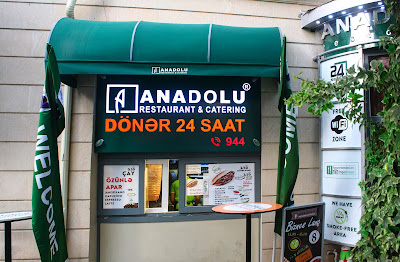Khash, or xas in Azeri, is a dish of boiled sheep's feet (trotters) and/or head and is a traditional breakfast dish in Azerbaijan and other countries such as Afghanistan, Albania, Armenia, Georgia, Iran, Iraq, Mongolia, Turkey and Bosnia and Herzegovina.
 |
| Sheep trotters (legs) from vidyascooking.blogspot.com. |
The sheep feet are depilated (the hair is removed from them), cleaned and kept in cold water, then boiled in water all night long until the water has become a thick broth and the meat has separated from the bones. No salt or spices are added during the boiling process. It is served hot along with add-ins such as salt, garlic and vinegar. Dried lavash, a soft, thin, unleavened flatbread is often crumbled into the broth to add substance. The tendons kind of melt into the soup and create a very thick broth and a silky taste. They say you eat it early in the morning and it makes you full the whole day.
It is also served with other foods, such as hot green and yellow peppers, pickles, pomegranate, radishes, cheese and fresh greens.
It is considered a winter food and served from September to April. In the Caucasus, including Azerbaijan, it is also viewed as a food to be consumed on the morning of a hangover.
One Azeri recipe for khash requires 2.2 pounds of sheep trotters (only the front feet), a carrot, an onion, 2 to 3 cloves of garlic, grape vinegar, salt and peppercorns. First, wash the sheep trotters, singe them with a cook's blowtorch to remove the hair, then wash them again. Use a cleaver to split the trotters along the joints into 2 to 4 pieces. Then put the trotters into a large pan and cover with cold water. Bring the water to a boil, remove the pan from the heat and discard the water which has formed a scum on top. Put the trotters back in the pan, cover with 6 to 8 inches of cold water, then bring it to a boil and then simmer on a low heat for 4 to 5 hours, traditionally overnight. At regular intervals skim off the scum that forms on the surface of the water. By adding the onion and carrot after the first skimming, it helps get rid of the scum. Remove the onion and carrot about halfway through the cooking. When ready, the meat will fall off the bones. You can either remove the trotters completely, or remove the meat from the bones and return the meat to the broth. Add salt and peppercorns and cook another 10 minutes. A relative to khash, known as kalla-pacha, is made from sheep trotters, a sheep's head and stomach (tripe).
Our first morning in Ajerbaijan, our guide Yalchin took us to the Anadolu Restaurant about a 10 minute walk from our hotel.
He told me that they serve about this traditional breakfast soup, khash, that will make me full the whole day.
 |
| Khash, or kas in Azeri. |
I ordered it (the others had omelettes) and the broth is extremely thick, a mixture of the collagen, marrow, gelatin, meat, fat and other ingredients from the trotters. It almost felt like that if you dropped in a quarter, it would be suspended in the mixture, or at least drop very slowly. The taste was very mild, it had absolutely no salt or other spices.
 |
| Very thick lamb broth with melted tendon, etc. |
However, Yalchin informed me that I should add in some vinegar, which reduced the thickness, some of the salty garlic mixture, which added some zip. I did it gradually, also adding some pomegranate arils, and could taste the difference, and ultimately put too much in.
 |
| Vinegar in a pitcher, creamed garlic in a red bowl and pickle, fig and other pickled type fruit in between. |
I had less than half of the cup, it truly was a freight-train of a drink.
 |
| Pomegranate arils and little lamb cakes which Yalchin said was mostly fat. I mixed some of the arils in the khash and at at the little lamb cakes, and they were pretty good. |
 |
| Azeri flat bread. After horrible bread most everywhere we'd been, we fell in love with the Azeri bread. There was dried flat bread that I did put in the khash. |
I tried some of the fig, pickle and other delicacies with it and could not get myself to get on board with it. Most of them were left uneaten.



As I recall, it was pretty gelatinous. It's one of those dishes where you can say, "Okay. I've tried that." No real need to try it again. I love that they call sheep feet "trotters," by the way.
ReplyDeleteinformative to me...
ReplyDelete